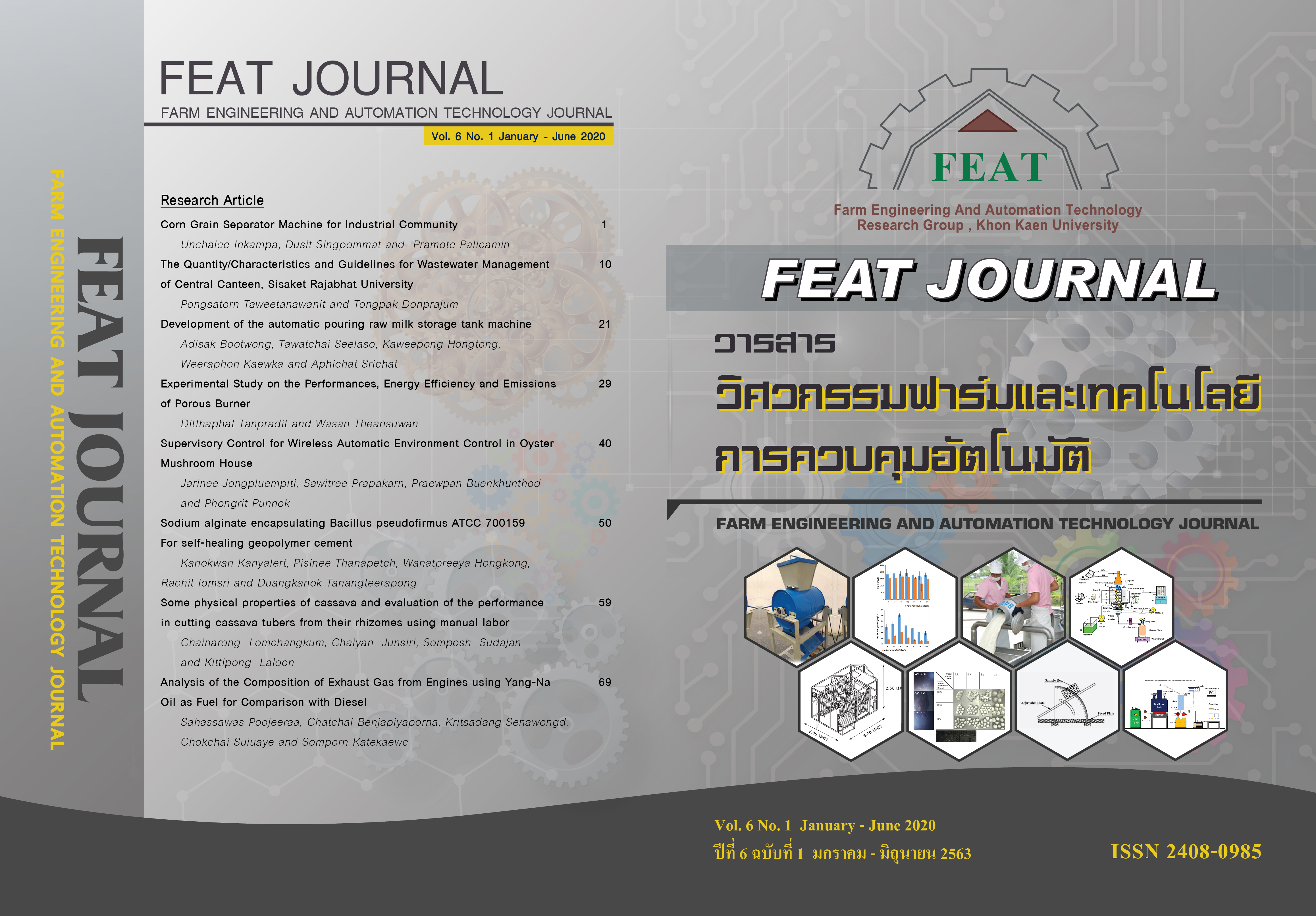โซเดียมอัลจิเนตห่อหุ้มแบคทีเรีย Bacillus pseudofirmus ATCC700159 สำหรับจีโอพอลิเมอร์ซ่อมแซมตนเอง
Main Article Content
บทคัดย่อ
จีโอพอลิเมอร์ซ่อมแซมตนเอง(self-healing geopolymer) ที่มีส่วนผสมของแบคทีเรียสามารถผลิตแคลเซียมคาร์บอเนตปกปิดรอยร้าวได้ แต่แบคทีเรียมีข้อจำกัดในการทนสภาพด่างแก่ของโซเดียมไฮดรอกไซด์ในขั้นตอนในการผลิตจีโอพอลิเมอร์ จึงได้มีการศึกษาการห่อหุ้มแบคทีเรียด้วยอัลจิเนตเพื่อที่จะเพิ่มอัตราการรอดชีวิตของแบคทีเรียในกระบวนการผลิตจีโอพอลิเมอร์ ในงานวิจัยนี้แบคทีเรียสายพันธุ์ Bacillus pseudofirmus ในระยะ endospore ถูกผสมเข้ากับ sodium alginate 0.5 % w/v และนำไปห่อหุ้มด้วยกระบวนการ extrusion technique โดยใช้เข็มเส้นผ่านศูนย์กลาง 0.8 มม. ก่อนนำสารห่อหุ้มนี้ไปใส่ในชิ้นงานจีโอพอลิเมอร์ ที่อัตราส่วน 10 และ 20 เปอร์เซ็นต์และทดสอบความแข็งแรงด้านแรงอัดที่ 7, 28 และ 60 วัน ตามมาตรฐานการทดสอบ ผลการทดลองพบว่าแบคทีเรีย Bacillus pseudofirmus ที่ปลดปล่อยออกมาจากเม็ดอัลจิเนตจะมีจำนวนเซลล์ตาย เท่ากับ 8.67±8.7%, 40.58±12.8%, 92.59±3.7% ในโซเดียมไฮดรอกไซด์ 10, 11 และ 12 M ตามลำดับ และจะตายมากที่สุดเมื่อแช่เป็นเวลา 80 นาที อย่างไรก็ตามแบคทีเรียที่ไม่ได้ผ่านการห่อหุ้มจะมีจำนวนเซลล์ที่ตายสูงสุดภายในเวลาเพียง 20 นาที จากผลการทดลองสามารถสรุปได้ว่า alginate encapsulation สามารถปกป้องแบคทีเรียจากกระบวนการผลิตจีโอพอลิเมอร์ซ่อมแซมตนเอง และเทคนิคสถิติ Fisher’s exact แสดงให้เห็นว่าสัดส่วนเม็ดอัลจิเนตที่ใส่ไปในชิ้นงานไม่มีความสัมพันธ์กับความแข็งแรงด้านแรงอัดของชิ้นงานจีโอพอลิเมอร์ (p<0.05)
Article Details
วารสารวิศวกรรมฟาร์มและเทคโนโลยีควบคุมอัตโนมัติ (FEAT Journal) มีกําหนดออกเป็นราย 6 เดือน คือ มกราคม - มิถุนายน และกรกฎาคม - ธันวาคม ของทุกปี จัดพิมพ์โดยกลุ่มวิจัยวิศวกรรมฟาร์มและเทคโนโลยีควบคุมอัตโนมัติ คณะวิศวกรรมศาสตร์มหาวิทยาลัยขอนแก่น เพื่อเป็นการส่งเสริมและเผยแพร่ความรู้ ผลงานทางวิชาการ งานวิจัยทางด้านวิศวกรรมศาสตร์และเทคโนโลยีพร้อมทั้งยังจัดส่ง เผยแพร่ตามสถาบันการศึกษาต่างๆ ในประเทศด้วย บทความที่ตีพิมพ์ลงในวารสาร FEAT ทุกบทความนั้นจะต้องผ่านความเห็นชอบจากผู้ทรงคุณวุฒิในสาขาที่เกี่ยวข้องและสงวนสิทธิ์ ตาม พ.ร.บ. ลิขสิทธิ์ พ.ศ. 2535
เอกสารอ้างอิง
[2] Mostafa, S. and Aydin, B. (2016). Bioconcrete: next generation of self-healing concrete. Springer-Verlag Berlin Heidelberg, 2016.
[3] Ali, M.K., Abu-Tair, A.I., Kinuthia, J.M., and Ryszard, B. Self - healing and strength development of geopolymer concrete made with Waste by products. International Conference on Biological, Civil and Environmental Engineering, 2015.
[4] Subhash V. and Patankar. Effect of Sodium Hydroxide on Flow and Strength of Fly ash Based Geopolymer Mortar. SRES College of Engineering, Kopargaon, 2012.
[5] Evandro, M. Denis, P. Ramila, C. and Denis, R. (2017). Oil encapsulation techniques using alginate as encapsulating agent: applications and drawbacks, November 2017, pp. 5-15.
[6] Hana, Ž. Jií, P. Zuzana, R. and Pavla, R. (2019). Effect of bacteria Bacillus pseudofirmus and fungus Trichoderma reesei on self-healing ability of concrete, Czech Technical University in Prague.
[7] สกลวรรณ ห่านจิตสุวรรณ์, ธนากร ภูเงินขำ และ ปริญญา จินดาประเสริฐ (2556). Study physical property of fly ash geopolymer paste. วารสาร วิชาการคณะเทคโนโลยีอตุสาหกรรม มหาวิทยาลัยราชภัฏลำปาง, 6, มกราคม 2556.
[8] S. Petraityt and A. Šipailien, “Enhancing encapsulation efficiency of alginate capsules containing lactic acid bacteria by using different divalent cross-linkers sources,” Lwt, vol. 110, no. November 2018, pp. 307–315, 2019.
[9] S. Luhar, S. Chaudhary, and I. Luhar, “Thermal resistance of fly ash based rubberized geopolymer concrete,” J. Build. Eng., 2018.


